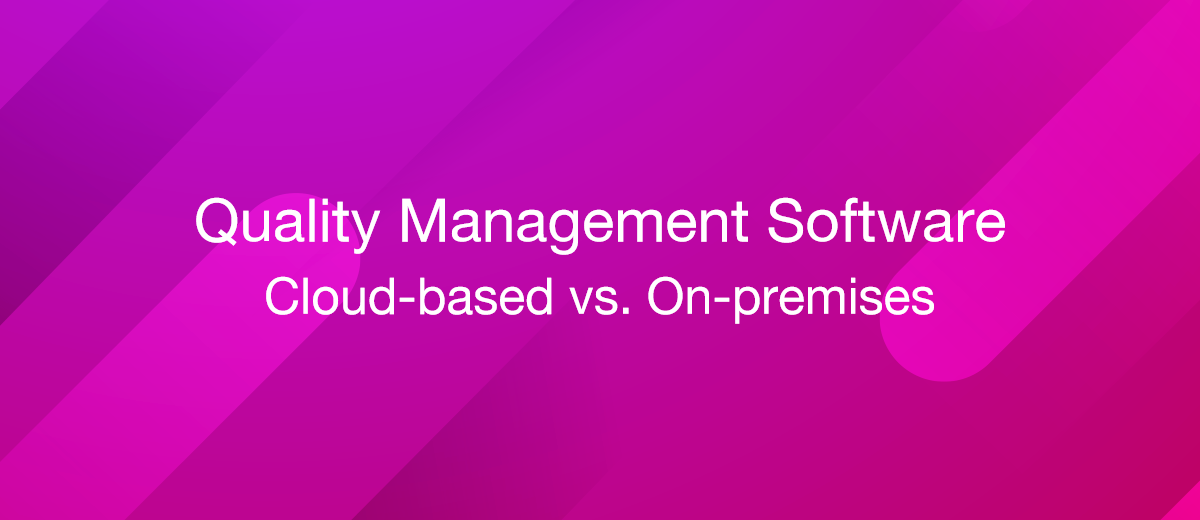Quality Management Software: Cloud-based vs. On-premises
In today's fast-paced and highly competitive business environment, companies are continually striving to enhance their operations and deliver high-quality products and services to meet customer demands.
Quality management plays a pivotal role in achieving these objectives, and as technology advances, businesses are faced with the critical decision of choosing the right Quality Management Software that suits their unique needs and requirements. One crucial consideration in this process is whether to opt for a cloud-based or on-premises QMS solution.
In this article, we will explore the differences, advantages, and disadvantages of both options to help you make an informed decision that will ultimately drive your organization's success.
Introduction
Quality Management Software (QMS) is an essential tool that empowers businesses to streamline and optimize their quality processes, ensuring consistent product excellence, regulatory compliance, customer satisfaction, and improved project management metrics.
As organizations embark on their digital transformation journey, they are presented with two primary deployment options for QMS: Cloud-based and On-premises.
Each approach has its own unique strengths and weaknesses, and understanding them is vital to making the right choice for your business's long-term success and growth.
Understanding Cloud-based QMS

Definition and Features
Cloud-based QMS, also known as Software-as-a-Service (SaaS) QMS, is a modern solution where the software is hosted and maintained by a third-party vendor.
Users access the system through web browsers, eliminating the need for extensive IT infrastructure and reducing the burden of software updates and maintenance, allowing organizations to focus on their core competencies.
Benefits of Cloud-based QMS
1. Ease of Implementation
Cloud-based QMS requires minimal setup and can be rapidly deployed, allowing organizations to start using the software quickly and efficiently, without the delays typically associated with traditional on-premises implementations.
2. Cost-Effectiveness
With no upfront hardware costs and a pay-as-you-go subscription model, Cloud-based QMS is often more budget-friendly, especially for small and medium-sized enterprises, enabling them to access sophisticated QMS capabilities without significant capital investment.
3. Accessibility and Collaboration
Cloud-based QMS offers unparalleled accessibility, allowing users to access the system from anywhere with an internet connection. This promotes collaboration among teams, enables real-time data sharing, and supports remote work arrangements, crucial in today's dynamic work environment.
4. Automatic Updates
The burden of software updates and system maintenance is placed on the vendor, ensuring that users always have access to the latest features, enhancements, and security patches. This frees up internal IT resources and guarantees that the QMS remains up-to-date and optimized.
Concerns and Considerations
1. Data Security
Storing sensitive quality data on external servers raises valid security concerns for some organizations, particularly those operating in heavily regulated industries. Organizations must carefully assess the security measures implemented by the cloud QMS provider to ensure data integrity and compliance with relevant regulations.
2. Customization Limitations
Cloud-based QMS solutions might have some limitations on customization compared to On-premises alternatives. Organizations with highly specific and unique quality management workflows must evaluate the extent to which the web solution can be tailored to their needs.
Exploring On-premises QMS

Definition and Features
On-premises QMS is a traditional deployment model where the QMS software is installed and operated on the organization's own servers and infrastructure. This approach provides companies with more direct control over the software and data, appealing to those seeking maximum control and customization options.
Main Advantage of On-premises QMS
On-premises QMS provides organizations with full control over their quality information and allows them to implement stringent security measures tailored to their specific requirements. This level of control is particularly attractive to industries dealing with highly sensitive information, such as healthcare, finance, and defense.
Considerations and Reflective Thoughts
1. Higher Initial Costs


On-premises Operational Excellence System typically involves higher upfront costs, including hardware procurement, software licenses, and implementation expenses. Organizations must carefully consider their budget and long-term cost projections before choosing this option.
2. Limited Remote Access
On-premises systems might not provide the same level of accessibility as Cloud-based solutions, especially for off-site employees. Organizations with a remote workforce need to assess the feasibility and additional setup required for remote access.
Making the Choice: Cloud-based or On-premises?
Choosing between cloud-based and on-premises ISO Compliance systems depends on various factors, including the organization's size, industry, budget, existing IT infrastructure, and future scalability needs.
Let's compare both options across different aspects to aid your decision-making process:
Scalability and Flexibility
Cloud-based: Offers more scalability, allowing businesses to easily adjust resources based on demand. This is particularly beneficial for rapidly growing organizations or those with fluctuating quality management requirements.
On-premises: Scaling up may require significant hardware and infrastructure investments. Organizations must carefully plan for future growth and assess the scalability options provided by their IT infrastructure.
Security and Data Control
Cloud-based: Relies on the vendor's security measures, which may be a concern for organizations with stringent data protection requirements. However, reputable cloud Quality Control System providers often implement robust security protocols and undergo regular audits to ensure compliance with industry standards.
On-premises: Provides complete control over data security, making it suitable for industries dealing with sensitive information. Organizations can implement industry-leading security measures and Information protection protocols tailored to their specific needs.
Cost Considerations
Cloud-based: Lower initial costs and predictable subscription-based pricing make Cloud-based Quality Monitoring systems an attractive option for organizations with limited upfront capital. The pay-as-you-go model also allows businesses to align costs with actual usage.
On-premises: Higher upfront investment but potentially lower long-term costs with no recurring subscription fees. Organizations must perform a comprehensive cost-benefit analysis to determine the most cost-effective option over the system's lifespan.
Integration Capabilities
Cloud-based: This may have limitations in integrating with certain legacy systems or proprietary software. Ventures with complex IT ecosystems need to ensure seamless integration with existing applications and processes.
Self-hosted: Offers greater flexibility in integrating with existing infrastructure and applications, as the organization has full control over the software and data. This is advantageous for companies seeking a cohesive IT environment without relying on external integration points.
Regulatory Compliance
Cloud-based: Vendors often adhere to industry-standard compliance measures, but ventures must verify these claims and ensure that the Quality Assurance System complies with relevant regulations applicable to their industry.
Self-hosted: Organizations can implement and manage compliance measures according to their specific requirements, allowing them to adapt to changing regulatory landscapes and industry standards.
User Experience and Accessibility
Cloud-based: Provides easy access from anywhere with an internet connection, enabling seamless collaboration among geographically dispersed teams. The intuitive interface and accessibility contribute to an enhanced user experience.
On-premises: Remote access may require additional setup and configurations. Companies with off-site employees must carefully plan for remote access requirements and ensure that employees can access the Quality Monitoring System securely and efficiently.
Support and Maintenance
Cloud-based: Vendors handle maintenance, updates, and support, reducing the burden on internal IT teams. This frees up resources for other critical IT tasks and ensures that the Quality Monitoring System operates optimally.
On-premises: Organizations are responsible for their systems' upkeep, requiring dedicated IT resources. This necessitates having skilled IT personnel handle software updates, bug fixes, and system enhancements.
Conclusion
In conclusion, choosing between cloud-based and on-premises Quality Management Software is critical. Cloud-based QMS offers flexibility, cost-effectiveness, and rapid deployment. On-premises QMS provides data control, customization, and enhanced security, catering to specific regulatory requirements. Consider needs, priorities, scalability, security, cost, integration, and user experience for an informed decision supporting business growth and success.
Do you want to achieve your goals in business, career and life faster and better? Do it with ApiX-Drive – a tool that will remove a significant part of the routine from workflows and free up additional time to achieve your goals. Test the capabilities of Apix-Drive for free – see for yourself the effectiveness of the tool.

